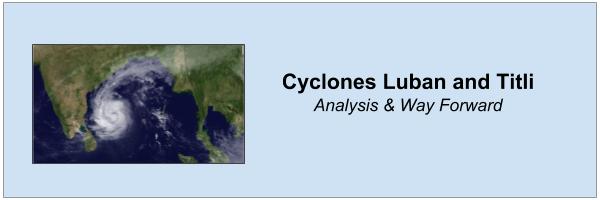(HOT) UPSC Current Affairs 2025 PDF
NEW! The Gist (NOV-2025) | E-BOOKS
Cyclones Luban and Titli : Important Topics for UPSC Exams

Cyclones Luban and Titli
The recent occurrence of two cyclones at the two coasts, Bay of Bengal and Arabian Sea cause great havoc in the region. Luban cyclone after a brief stopover, become a severe cyclone in the west-central Arabian sea. Bay of Bengal, on the other hand, get the host of cyclonic storms Titli. Both the cyclones have been put under the severe categories.

However, landfall of cyclone Titli over the eastern coast of India is very devastating. Squally winds with speeds reaching up to 90 Km/Hour and gusting to 100 Km/Hour are likely over the deep seas of the central and adjoining North Bay of Bengal the same day.
Damages in the Eastern Coast-
- The most severely affected state by the Titli was Odisha. The storm affected 16 out of the 30 districts of the state.
- More than 5 million people in the state were affected. Incidents of heavy rainfall and landslides are very common during this storm period.
- The state has also seen immense infrastructural damage, which highlights the long term economic loss that accompanies natural disasters.
- Andhra Pradesh also faces disaster because of Titli.
What is tropical cyclones?
- Both the cyclones Luban and Titli put under the tropical cyclone category. Tropical cyclones inherently are more devastating and causes great losses.
- Violent storms that originate over oceans in tropical areas and more over to the coastal areas bringing about large scale destruction due to violent winds (squalls), very heavy rainfall (torrential rainfall) and storm surge.
- In tropical cyclones, Irregular wind movement involving closed circulation of air around a low pressure center occur.
- This closed circulation is the result of Coriolis force due to the rotation of the earth.
- Wind movements are anti clockwise in northern hemisphere and clockwise in southern hemisphere.
Origin and development of Tropical Cyclone-
- Tropical cyclones have thermal origin and they develop over tropical seas during late summers.
- At these location the strong local convection currents acquire a whirling motion because of the Coriolis force.
- India with a long coastline of 7516.16 Km is one of the worst affected regions, where it is exposed to 10% of the tropical cyclones in the world.
Condition of Cyclonic Disaster Preparedness and Management in India-
- India is highly vulnerable to natural disasters especially cyclones, earthquakes and landslides etc.
- According to Home Ministry, nearly 8% of the total area in India is prone of cyclones.
- Indian Meteorological Department (IMD) is the nodal agency for the early warning of cyclones and floods.
- National Disaster Management Authority (NDMA) has already prepared national guidelines on management of cyclones.
- Home Ministry has also launched National Cyclone Risk Mitigation Project (NCRMP) to upgrade the forecasting, tracking and warning about cyclones in states.
- The National Disaster Response Force (NDRF) is the executing body that performs rescuing and managing relief work.
In 2016, a blueprint of National Disaster Management plan was unveiled to tackle disaster. According to plan, Ministry of Earth Science will be responsible for Disaster management of cyclones. By this plan, India has joined the list of countries which follow the Sendai framework for Disaster Risk Reduction 2015-30.
Issues associated with Cyclone Disaster preparedness in India--
- The Indian disaster preparedness machinery largely focus over the post disaster relief works, more about management than prevention.
- Marginalized communities in the coastal regions are mostly ill-prepared and unable to cope-up with disaster.
- There is a lack of proper coordination between the central and state governments and its agencies.
- There is also a lack of coordination between the local communities for search and rescue mission.
Steps to be taken-
- There is a need to harmonize the national and local level disaster resilient by-laws, land use zoning, resource planning, early warning system establishments and technical competencies.
- Model of success stories like Built Back Better program of Gujarat Government after 2001 earthquake need to be inculcated.
- There is a need to move away from risk-blind approach to the risk-informed decision when comes to infrastructural projects. There is also a need for Disaster Risk Audit for future developmental project for both public and private entities.
- Disaster management plan should be more inclusive that include women, civil society and academia.
Way forward-
Natural phenomena are very unpredictive. What we can do is to prepare ourselves to mitigate the destructions caused by cyclones. But for that we need to come up with better technological aspirations. Strict command and coordinated structure along with the participation and cooperation of local communities are inevitable.
Multiple Choice Question-
Q. Which of the following is/are the conditions for the formation of tropical cyclone?
1. Large sea surface with temperature higher than 27 degree.
2. A pre-existing high pressure area.
3. A high variations in the vertical wind speed.
i. Only 1
Ii. Only 1 and 2
Iii. Only 1 and 3
Iv. All the above
Answer is i
Hint- Only 1 is correct.
Mains-
A question may be asked in GS 1 paper in geography section. There are also chances a question over disaster management from this topic itself. The format may be--
Q. India accounts for nearly 10% of all the tropical cyclones in the world. The country has progressed significantly in planning and managing this disaster effectively, but there still remains some drawbacks in the present situation. Comment.
Hint-- Here we need to put up a comprehensive view related to the topic. Start with the cyclonic situations in both the major coasts of India. Try to strengthen it with some name like Luban and Titli. In body try to mention important developments in cyclonic disaster management. Discuss major loopholes and conclude with a way forward. I have mentioned important points try to put them while writing answer.

